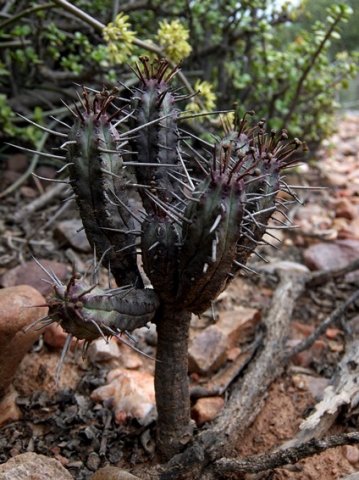Euphorbia heptagona tree aspirations

Author: Ivan Lätti
Photographer: Thabo Maphisa
All plants respond to different prevailing living conditions of time and place to keep alive, sometimes ending up in unusual shapes. Higher branching of one stem only was observed in this Euphorbia heptagona, seen in stony veld in the Kammanassie.
A complete “personal” history of particular events over a lifetime almost never exists for any plant in the veld. Neither for any animal or person. Such a historical record would have shown an unbroken logical sequence of all earlier growth responses to all impacting conditions, ending in this shape.
Stem base markings indicate where branches had dropped off in picture. This is proof of a very different, more conventional structure the plant had earlier. Plant shape is always a function of time, for growth is a must for the living. Life is drama in momentary transformation, at normal speed or envisaged in slow motion or at high speed.
Identity, or that which one is, remains stable in some respects, as well as changes dynamically in others; in all it comprises the becoming during a lifetime. Stable for living things means only temporarily durable. Each species contains the range of its possibilities. Wordsworth's "the child is father of the man" is a thought-provoking paradox, also applying in the world of plant development.
Fluctuating fortunes impact on the resultant appearances during every era or life phase of every specimen uniquely. This brings another three-part paradox: specific uniformity contrasts with individual differences and ultimate uniqueness.
Every plant, like every other living entity remains alive continually for the duration of an allotted time interval, reproducing as best it can according to its nature during a part of that interval. To achieve this, it uses the inherent unit potential allotment of its species for as long as it can. Fortunes change amidst differences in size, shape, behaviour and environmental opportunities not shared with its mates, its "equals".
All these things impact on the variability that optimises continued life in some form. The statement is like a botanical version of the adage that life happens while we’re making other plans. Or not, for where’s the mastermind in a plant?

